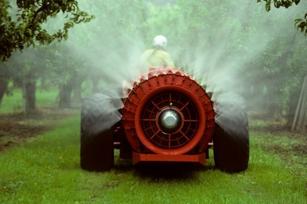The answers to those questions remain murky, because little research has been done. But evidence is building that the way we think about pesticide risk, especially in children, is all wrong. A few years ago, scientists at Emory and the University of Washington showed that when children switched to organic fruits and vegetables, pesticide residue in their bodies (as measured in their urine) dropped significantly within days. But what wasn't clear at the time was the pesticide load in a typical kid's diet, since the scientists in the organic study had themselves established the diet given to the kids.
Now, Chensheng Lu, the lead scientist involved with the earlier study, has come out with a new one, along with a team of government and university researchers. This time, he and his team analyzed the pesticide residue on the fresh fruits and vegetables that parents gave their kids. The researchers analyzed the fruit-and-veg consumption of two groups of kids, one from Washington state and one from Georgia.
They found, as expected, a witch's brew of organophosphate and pyrethroid pesticides - both of which are endocrine disruptors and have suspected neurological effects - on the fresh fruit and vegetables the study participants ate. Organophosphates, by the way, are the direct descendants of VX and Sarin nerve gases and were recently linked to the development of ADHD in kids.
Now, the individual pesticides were present at levels more or less consistent with what the government considers "safe" (with a few notable exceptions). But that's far from the whole story. The researchers clearly demonstrated that seasonality plays a huge role in kids exposure to pesticides in these classes. In other words, in apple season kids eat a lot of apples-- and, along with them, much higher levels of organophosphates than previously estimated. As obvious as this conclusion is, it's not really one that is acknowledged in current government estimates.
This effect implies that in practice, kids can see seasonal spikes in exposure levels. And that means that the residue levels considered safe may need to be rethought. Consider an apple carrying traces of organophosphates at a level deemed safe. Consuming one a week might indeed be harmless. But if a kid eats seven or 10 in a week because they're readily available, she might be ingesting enough organophosphate traces over a concentrated period to be courting trouble.
Meanwhile, the kids in the different regions were exposed at different rates to the different pesticides - the Washington kids got hit with more organophosphates while the Georgia kids were exposed to higher levels of pyrethroids. And the kicker? About half of the top 12 fruits and vegetables most consumed by kids in the study are members of the Environmental Working Group's "Dirty Dozen" [PDF]; that is, the 12 fruits and vegetables that typically have the highest levels of pesticides. And consumption of many of those would come in seasonal spikes as well.
Until this study, no one had been able to do anything more than theoretically estimate the total pesticide exposure kids experience when they eat conventionally grown foods. The results of these models don't incorporate regional variation in diet and pesticide use or even seasonal variation in what fruits and vegetables are available.
There are no easy conclusions here. No one wants to see kids cut down on fruit and vegetable consumption; they're already consuming too few of these nutrient-dense foods. But we also don't want to see them disrupting their normal development or courting ADHD by eating peaches. The cost-benefit calculations are impossible to make without more information. What this study is telling us is that we're seriously underestimating how much of these dangerous pesticides - chemicals that can affect kids' growing brains and bodies - our kids are getting at any one time. For policy makers, the challenge is to create incentives for farmers to move away from poisons as a pest-control strategy.
In the mean time, how should parents respond? According to Environmental Working Group, rinsing helps, but doesn't solve the problem. "The data used to create [the Dirty Dozen and Clean 15 lists] is based on produce tested as it is typically eaten (meaning washed, rinsed or peeled, depending on the type of produce)," EWG writes. The takeaway:
Rinsing reduces but does not eliminate pesticides. Peeling helps, but valuable nutrients often go down the drain with the skin. The best approach: eat a varied diet, rinse all produce and buy organic when possible.About the author
Tom is a writer and a media & technology consultant who thinks that wrecking the planet is a bad idea. He twitters and blogs here and at Beyond Green about food policy, alternative energy, climate science and politics as well as the multiple and various effects of living on a warming planet.




Stop eating fruits and vegetables and go back to the junk food, Rats can't be wrong can they.